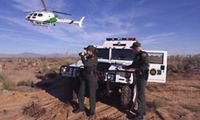Bush signs law to build fence at US-Mexico border
Friday, October 27, 2006


(Image missing from Commons: image; log)

Today U.S. President George W. Bush signed into law the Secure Fence Act of 2006, a plan to build a 700 mile (1,125 kilometer) fence between the United States and Mexico, to prevent illegal immigration. Mexico has expressed strong opposition to the fence, which covers about one third of the total border length.
"Unfortunately, the United States has not been in complete control of its borders for decades and therefore illegal immigration has been on the rise," Bush was quoted saying. "Ours is a nation of immigrants. We're also a nation of law... We have a responsibility to address these challenges. We have a responsibility to enforce our laws. We have a responsibility to secure our borders. We take this responsibility seriously," the President explained.
Congress passed the bill last month with a convincing majority, but the signing has been delayed until now, 12 days before the mid-term elections in the U.S. Yesterday the president already envisioned funding and manpower increases for border control, and extra beds to counter the "catch-and-release at our southern border".
Earlier this month, Bush arranged a $1.2 billion budget for the fence, along with cameras, sensors, satellites and other security measures, to create a "21st-century" border —but the fence alone is roughly estimated to cost twice that amount. A U.S. poll this week showed that there are more Americans in favor of an increased number of Border Patrol agents, while less then half of those questioned agreed with the fence.
According to the BBC, about 10 million Mexicans live in the U.S., and about four million of them are estimated to be illegal. Though, since illegal immigrants are not registered in any official sense, this number may be much higher, and other figures have circulated in the press. Bush has declared he will attempt to counter "widespread document fraud", and opposes the idea of granting illegals who work in the U.S. quick citizenship, or amnesty. According to Bush, "There is a rational middle ground between granting an automatic path to citizenship for every illegal immigrant and a program of mass deportation, and I look forward to working with Congress to find that middle ground."
Since Bush took office, he said, about 6 million have been intercepted and deported. Mexico previously said it deplored the idea, and considers taking this to the United Nations. The Organization of American States also expressed "deep concerns" over the fence, calling the proposal "a unilateral measure that goes against the spirit of understanding that should characterize how shared problems between neighboring countries are handled and that affects cooperation in the hemisphere." The outgoing Mexican President Vicente Fox has compared the fence with the Berlin Wall, while President-elect Felipe Calderon thought it was a "grave mistake", and also that "the fence doesn't resolve anything", causing more casualties along the border. Other politicians in Mexico accused the U.S. of hypocrisy, benefiting from cheap Mexican workers but not allowing them to acquire citizenship.

T.J. Bonner, who heads the National Border Patrol Council, told AP that "A fence will slow people down by a minute or two, but if you don't have the agents to stop them it does no good. We're not talking about some impenetrable barrier."
The immigration issue has divided the U.S. Republican party recently, and has brought many demonstrators to the street. The plan could have been balanced with measures to legalize some immigrants already in the U.S., and a foreign worker program, but Bush couldn't convince many of his Republican Party colleagues.
Sources
- "Mexico anger over US border fence" — BBC News Online, October 27, 2006
- Kathleen Koch. "Bush OKs 700-mile border fence" — CNN, October 26, 2006
- "Bush signs Mexico fence into law" — BBC News Online, October 26, 2006
- "Bush bekrachtigt bouw hek langs Mexicaanse grens" — De Standaard, October 26, 2006 (Dutch)
- James Westhead. "Immigration tears Republicans in two" — BBC News Online, May 17, 2006